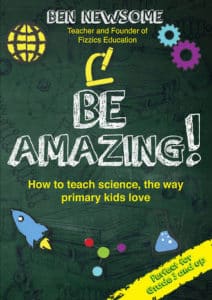
Bring out the power!
Who doesn’t science when it’s super-sized!?! A leaf blower is such a ubiquitous tool for the home and kids know it put out a fair bit of air … why not use it to teach kids about air pressure in some fantastic science demonstrations that’ll certainly grab their attention 🙂
Flying toilet paper experiment

Gotta love the flying toilet paper science experiment! Photo was taken during a teacher development workshop.
This demonstration always grabs the kids attention! We use the flying toilet paper experiment during the Big Science Big Fun science show as well as the Flight & Pressure show for schools as it shows how aerofoils work in a highly visual way. The idea is that the curve of the toilet paper roll effectively acts like the cross-section of a plane or bird wind – by blowing fast moving air over the top of the paper you create an area of low air pressure above the paper (see Bernoulli experiment). The slower air underneath the paper has much higher pressure than above the paper, therefore it can lift the toilet paper up into the air and you get flight! Closer inspection also allows students to learn about the Coanda effect which describes the phenomenon of air flows sticking to surfaces, even when they curve away from the air flow. All you have to do is attach the toilet paper to a paint roller and point a leaf blower at it … presto!
Floating ball experiment

Kids love the ‘levitating’ beach ball experiment!
You might recognize this experiment from one of those vacuum cleaner shops; a beach ball seems suspended in mid-air over a vacuum cleaner blowing air upwards at an angle. I know that whenever my kids go past the vacuum cleaner shop they are always on the lookout for the ‘floating ball’! It’s very easy to repeat, however, just a little harder to explain. According to Bernoulli’s theorem, fast-moving fluids have lower pressure than slow moving fluids. This means that there is a low-pressure area where the air is leaving the nozzle of the leaf blower (this almost seems counter-intuitive). If you carefully balance the beach ball in the spot where the forces of gravity and air pressure are roughly equal, your beach ball will float!
What is happening is that your beach ball is pushed towards the leaf blower by the force of the slow-moving air above the ball.
It takes a little practice for students to get the setup right but eventually you’ll be able to find that you can place a ball onto a vertical stream of air coming from the leaf blower and then slowly tip the angle of the leaf blower to almost 45 degrees from the vertical with the beach ball still trapped in the air stream. A smaller version of this science experiment is that done with a hair dryer and a ping pong ball, or you could try a funnel and a ping pong ball experiment too.
Make a hovercraft

You’d be surprised weight how much the leaf blower hovercraft! can move!
A leaf blower hovercraft is a spectacular demonstration of applying forces for students! You’ll need to get out the tools though as there are several things that need to be made. The first job is to create the hovercraft bag out of some construction plastic (make it into a rectangle). The second job is to cut a wide rectangle out of some marine plywood that is a bit smaller than the construction plastic you just cut. The third job is to use a hole saw to cut out a hole for the leaf blower nozzle to fit (make it tight). The fourth job is to wrap the plywood base with the construction plastic and then use strips of wood and screws as clamps to secure the bag in place. Next, you need to find the centre of the construction bag where you’ll drill a hole through both the plastic bag and the plywood to secure a flat plastic disk to distribute the air from the centre of the hovercraft bag. Finally, you need to use some scissors to cut out six holes in the construction plastic in a circle around the plastic disk in the centre.
If all goes well you should be able to turn on the leaf blower and raise the hovercraft off the ground and it should stay relatively stable! The moment of truth is trying out the leaf blower hovercraft and getting someone to carefully move you along just like the picture above. You should find it fairly easy to move people as the force of the air has lifted the hovercraft off the floor and therefore there is less friction that would normally resist you moving that person. Great fun, just do this in the presence of a competent adult!
So, perhaps this school term you could try out one of these science experiments with your class. If time is a bit short you could have us visit your school to show the students how these experiments work, we have fun with these activities too!
Happy teaching,
NEW Primary science teaching book!
“Be Amazing! How to teach science, the way primary kids love”



























Comments